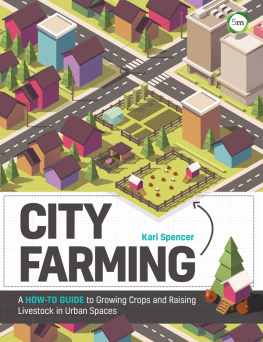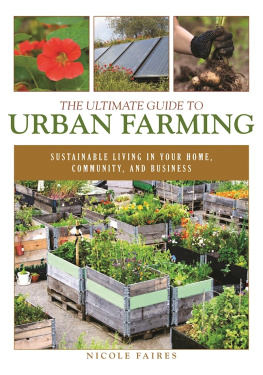2nd Edition
Urban
Farming
Sustainable City Living in Your Backyard,
in Your Community, and in the World
Thomas J. Fox

URBAN FARMING
CompanionHouse Books is an imprint of Fox Chapel Publishers International Ltd.
Project Team
Vice PresidentContent: Christopher Reggio
Editor: Amy Deputato
Copy editor: Jeremy Hauck
Design: Mary Ann Kahn
Index: Elizabeth Walker
Copyright 2018 by Fox Chapel Publishers International Ltd.
All rights reserved. No part of this book may be reproduced, stored in a retrieval system, or transmitted in any form or by any means, electronic, mechanical, photocopying, recording, or otherwise, without the prior written permission of Fox Chapel Publishers, except for the inclusion of brief quotations in an acknowledged review.
ISBN 978-1-62008-301-7
Library of Congress Cataloging-in-Publication Data
Names: Fox, Thomas J., author.
Title: Urban farming : sustainable city living in your backyard, in your
community, and in the world / by Thomas J. Fox.
Description: 2nd edition. | Mount Joy, PA : Fox Chapel Publishing, [2018] | Includes bibliographical references and index.
Identifiers: LCCN 2018032077 (print) | LCCN 2018037304 (ebook) | ISBN 9781620083024 () | ISBN 9781620083017 (softcover)
Subjects: LCSH: Urban agriculture. | Sustainable agriculture. | Vegetable gardening.
Classification: LCC S494.5.U72 (ebook) | LCC S494.5.U72 F69 2018 (print) | DDC 635.9/77--dc23
LC record available at https://lccn.loc.gov/2018032077
This book has been published with the intent to provide accurate and authoritative information in regard to the subject matter within. While every precaution has been taken in the preparation of this book, the author and publisher expressly disclaim any responsibility for any errors, omissions, or adverse effects arising from the use or application of the information contained herein.

Fox Chapel Publishing
903 Square Street
Mount Joy, PA 17552 | Fox Chapel Publishers International Ltd.
7 Danefield Road, Selsey (Chichester)
West Sussex PO20 9DA, U.K. |
We are always looking for talented authors. To submit an idea, please send a brief inquiry to .
Printed and bound in China
21 20 19 182 4 6 8 10 9 7 5 3 1

Contents
Dedication
To my mom, for a love of writing; my dad, for a love of gardening; my wife, for a love of life; and my boys, with great love and hope for a greener future.
Acknowledgments
Thank you to Andrew DePrisco, who opened the door to the book; to Karen Julian, who ushered it through; and to my two crack editors, Jennifer Calvert and Amy Deputato, who lifted the peaks and filled in the valleys with extraordinary skill and restraint. Derek Burnett deserves tremendous credit for his expert help on this book, as well as other projects. Id also like to acknowledge the many people who tolerated my ignorance with grace, taught me so much, and shared their enthusiasm for urban agriculture, among them Martin Bailkey, Rick Bayless, Don Boekelheide, Natalie Brickajlik, Fred Brown, John Cannizzo, Roxanne Christensen, Virginia Clarke, Mary Seton Corboy, Daniel Dermitzel, Wes Duren, Danielle Flood, Lorraine Gibbons, Carole Gordon, Jennie Grant, Mike Hamm, Sherilin Heise, Gregory Horner, Jonathan Jones, Jerry Kaufman, Aley Kent, Erik Knutzen, Michael Levenston, Andrew McCaughan, Michael McConkey, Joe Nasr, Molly Philbin, Robert Philbin, Gordon Prain, Jessica Prentice, Martin Price, Brooke Salvaggio, Wally Satzewich, Bob Scallan, Mike Score, Jill Slater, Jac Smit, Lena Carmen Soileau, and Brenda Tate. It would have been a much poorer book without them, and a much less enjoyable task of writing.

INTRODUCTION
In January 2009, I answered an ad posted with the Editorial Freelancers Association seeking a writer for a book on city living/urban farming. I jumped at the chance. At the time, Id spent most of my adulthood living in cities, and Id written about and for environmental organizations based in them. Some of my most vivid memories of my childhood were the cucumbers and asparagus my father grew in the narrow stretch between our suburban homes.
The person who had posted the ad wrote back to ask what Id write about. I pitched an outline and was eventually chosen to write the book.
Still... urban farming. Back then, urban farming was like salad couch. Sure, you could smoosh the two words together, but what the hell would you be talking about?
Of course, just because the idea of urban farming might have struck Americans as odd in the early twenty-first century, thats not to say that the practice of urban farming was new. It was woven throughout the history of North America, most famously in the Aztec capital of Tenochtitlan, now known as Mexico City. It was practiced throughout world history, in fact, and wasnt just a thing of the past. Greensgrow Farm has thrived in Philadelphia since 1997, the Dervaes family has maintained an urban homestead in Pasadena since 1985, and City Farmer has been doing it in Vancouver since 1978. And those are just three well-known examples among countless others.
Indeed, I discovered that urban agriculture had been seriously considered by some in the development community since 1996, when Jac Smit and Joe Nasr published Urban Agriculture: Food, Jobs and Sustainable Cities for the United Nations Development Program (UNDP). But somehow the terms urban farming and urban agriculture hadnt quite made it to American public consciousnessat least based on the blank stares I received whenever I would tell people I was writing a book on urban farming.


Talk about local color! Beautiful local produce adorns farmers markets across the nation and around the world.
The concept seemed at best exotic, if not entirely oxymoronic. There didnt seem to be much in the way of nonacademic books squarely addressing the topic. Growing food was just one aspect of Kelly Coynes and Erik Knutzens Urban Homesteading, which covered a wider set of lifestyle issues, while other existing books applicable to city farmers focused more narrowly on some combination of technical or philosophical issues, like Mel Bartholomews Square Foot Gardening or H.C. Floress Food Not Lawns.
In other words, I hoped to make a minor contribution to a very obscure field about which almost nothing seemed written outside of international development organizations and other specialists. A few months later, while I was still researching this book, Novella Carpenters Farm City: The Education of an Urban Farmer came out (Fresh, fearless, and jagged around the edges, as Dwight Garner described it in the
Next page














